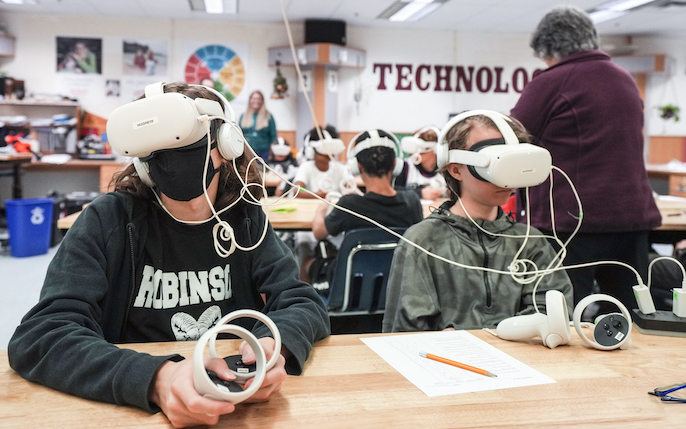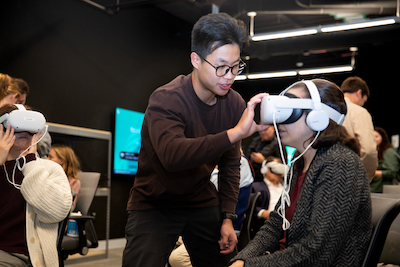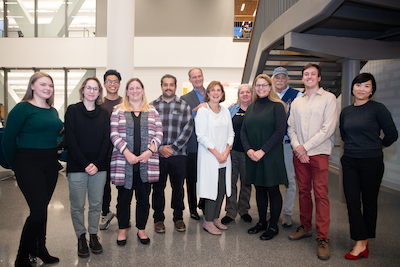In This Story

Faculty, staff, and students from three units across George Mason University have worked together to create a new virtual reality (VR) experience for elementary students. Through an immersive nine-minute video, students can take a “field trip” to the Mason apiary, learning from an expert beekeeper, taking a deep dive into a hive, and even flying like foraging honey bees.

Funded by the Sweet Virginia Foundation, a Northern Virginia-based environmental education nonprofit, this new learning tool is a collaborative venture with the School of Business, which houses the Honey Bee Initiative (HBI), the College of Education and Human Development (CEHD), and the College of Engineering and Computing (CEC). The “field trip” is designed to enhance existing pollinator curricula taught in Virginia fourth-grade classrooms, and foster interest in science, technology, engineering, and math (STEM) and STEM careers in today’s youth.
The idea for the virtual field trip began nearly a decade ago with Daniel Price, founder of the Sweet Virginia Foundation, and Mason professor Lisa Gring-Pemble, HBI co-founder. Enter Mason researcher Carley Fisher-Maltese, an assistant professor in the CEHD, who helped make that dream a reality.
The 360-degree video features Sarah Red-Laird, founder and director of The Bee Girl Organization, which is widely known for teaching kids, beekeepers, and farmers how to “love their bees,” and students from Willow Springs Elementary School in Fairfax, Virginia. The video was created by CreatorUp!, a California-based video production company.

“This virtual field trip engages elementary school children in learning about the plight of honey bees, and their relationship to food security,” said Gring-Pemble, who is also the co-executive director of the Business for a Better World Center. “We have a moral imperative to educate our students about sustainability issues like honey bees, which are dying at an alarming rate. Bees pollinate much of the food we eat so our very survival is dependent on bees.”
Fisher-Maltese, who is leading the research initiative, said the idea behind the VR experience was to create a field trip for students who don't have access to resources like apiaries and beekeepers. “We were excited about the virtual reality technology because we felt like the experience could be really immersive and make the students feel like they were there.”
A special screening of the video was held on the Fairfax Campus in late October before it debuted in five public and private local elementary and secondary schools.
Fisher-Maltese and Gring-Pemble were funded by the National Science Foundation (NSF) for bee research. Many came together to build the script for the virtual reality (VR) experience. CEC’s Craig Yu, and his students, computer science major Quang Vo and computer game design major Jake Wojtecki, also assisted in the project.

Fisher-Maltese calls this video experience the scaled-down version of what they hope to create: an interactive, multi-user experience where the student could virtually “be a bee.” Right now, the team is piloting the video with fourth- and fifth-graders in Alexandria City and Fairfax County public schools, and using instruments like a VR sickness questionnaire to get feedback on whether students experienced motion sickness from the VR and a content measure to see if they learned anything from the video. They also conducted focus group interviews with the students and one-on-one interviews with the teachers.
The team also had the opportunity to share the video with high school students in Technology Teacher Amy Krellwitz’s advanced engineering class at Robinson Secondary School in Fairfax who were looking at the experience through an engineering lens.
“They had really good feedback,” Fisher-Maltese said of the high school students. “It was a lot of things we were already thinking of—make it more interactive, make it more like a video game, but it was good to have that confirmation.”
Fisher-Maltese added, “I think the research will show that this type of immersive experience demonstrates the convergence of emotion, wonder, and meaningful learning.”
“It truly was a wonderful experience to see young people, from elementary students through high school students, getting excited about honey bees and the vital role they play in human security,” said Gring-Pemble. “The passion these young people have for caring for the natural world is what will ultimately change human behaviors in favor of protecting our planet.”
At the special screening, the team thanked Price, who has supported HBI since its inception in 2013. “Dan had a dream of bringing the awe and wonder of bees to elementary school students,” said Gring-Pemble. “Our partnership has resulted in [this] coming to fruition.”
“We are incredibly grateful and proud of our collaboration with Mason,” said Price. “Our goal is a happier, healthier planet. We think we can ‘push the needle’ in that direction by sparking a sense of wonder in children.”
In addition to Price and School of Business Dean Ajay Vinzé, Gring-Pemble also thanked many members of the team who made the project possible, including CEHD Dean Ingrid Guerra-López and CEHD early childhood education graduate students Regan Wilson and Xiaolu Zhang, CEC Dean Ken Ball, Vice President of Facilities Frank Strike and his team, and the team that shot aerial footage of Mason (Mason Forensic Science professor Steve Burmeister, Deputy Chief Michael Lighthiser of Mason Police and Public Safety, and Captain John Jeneic Jr. of City of Fairfax Fire Department).
